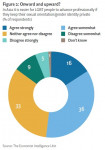China surpasses the “ASEAN 7” in high-value exports, says a new Economist Intelligence Unit study
According to a “high-value exports indicator” for 2005 prepared by the Economist Intelligence Unit for this paper, high-value goods accounted for 51% of South-east Asia’s total exports, but 61% of total exports from China·and the share of high-value goods in China’s exports has been climbing. China overtook the ASEAN 7 in terms of high-value exports in 2003, and a year later outpaced the trade bloc in terms of total exports. Indeed, of all the large countries and trade blocs analysed in the briefing paper, only China demonstrates a rising proportion of high-value exports. India remains firmly behind both China and South-east Asia.
On an individual country level, China ranks third in terms of the proportion of high-value goods in total exports. The high-value exports indicator, which looks at high-value goods as a percentage of total exports (see table), gives first position to the Philippines, which reports that high-value goods make up 77% of its total exports. This places it well ahead of other individual ASEAN countries, China and India, as well as countries within the North American Free Trade Agreement (NAFTA) and the European Union (EU). One explanation for the Philippines’ ranking could be that its percentage share of high-value exports has been artificially skewed because its low-value exports have been falling. In second and fourth positions on the indicator are Singapore and Malaysia, whose high-value exports make up 68% and 57% respectively of their total exports. At the bottom are Vietnam and Myanmar, whose exports are predominantly low-value.
The high-value exports indicator puts the ASEAN 7 ahead of the EU, but trailing NAFTA. The proportion of high-value exports in the three trading blocs appears to have declined between 2000 and 2005. One possible reason is that prices of commodities, such as oil, soared during this period, inflating the proportional share of low-value exports. However, the decrease in the share of high-value exports has been slowest in ASEAN. The faster decrease in Europe and North America, may reflect the increasing trend for companies to outsource manufacturing overseas, according to the briefing paper.
The analysis broke down all exports into two categories: high-value and low-value. High-value exports are those that generate a lot of value-added in their production, such as engines, gas turbines, computers and cameras. By contrast, low-value goods include bulk commodities, such as oil, tin and rice, and also manufactured goods that generate only a small amount of value-added, such as textiles and garments. This distinction is important because jobs producing high-value exports (such as computer chips) are likely to be better paid, better skilled, less physically demanding and more technologically advanced than those producing low-value exports (such as t-shirts).
The briefing paper also identified key policy areas that ASEAN governments could adopt to nurture and attract high-value manufacturing industries, such as:
· The creation of a genuinely integrated, single market. ASEAN still depends heavily on demand from outside the trading bloc to fuel its manufacturing and exports. For ASEAN to become more attractive as a manufacturing location, tariffs must continue to be lowered, and non-tariff barriers dismantled. That means, among other things, standardising product and technical regulations, and harmonising testing and licensing procedures.
· Modernisation of trade and customs procedures. Customs infrastructure in many parts of ASEAN needs upgrading. For example, traders should be able to submit trade documents electronically. Equally, customs rules and procedures must be standardised. As manufacturing supply chains get ever leaner, speed of delivery of goods becomes more and more important, so smooth, efficient import and export processes become vital.
· Investment in infrastructure. Factories need efficient ports, roads, railways and airports. They need cheap and reliable electricity and telecommunications. But some parts of South-east Asia have under-invested in such infrastructure essentials, and this will put off investment in new manufacturing plants.
웹사이트: http://www.eiu.com
연락처
Edgar Fernandez
Marketing Manager, Asia-Pacific
(852) 2585 3826 이메일 보내기
Fax: (852) 2802 7007
이 보도자료는 Economist Intelligence Unit가(이) 작성해 뉴스와이어 서비스를 통해 배포한 뉴스입니다. 뉴스와이어는 편집 가이드라인을 준수합니다.




